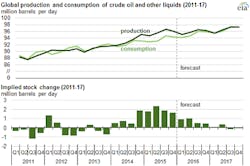Oil prices to remain relatively low through 2017, says EIA
Offshore staff
WASHINGTON, D.C. – In its most recent “Short-Term Energy Outlook,” the US Energy Information Administration forecasts Brent crude oil prices will average $40/bbl in 2016 and $50/bbl in 2017. West Texas Intermediate (WTI) crude oil prices are expected to be $2/bbl lower than Brent in 2016 and $3/bbl lower than Brent in 2017.
EIA recognizes that there is still high uncertainty in the crude oil price outlook. For example, the agency’s forecast for the average WTI price in April 2016 is $37/bbl, while the market expects WTI prices to range from $25/bbl to $56/bbl (at the 95% confidence interval) based on the recent prices of futures and options contracts for April 2016 delivery.
Crude oil prices are expected to remain low as supply continues to outpace demand in 2016 and more crude oil is placed into storage. EIA estimates that global oil inventories increased by 1.9 MMb/d in 2015, marking the second consecutive year of inventory builds.
Inventories are forecast to rise by an additional 0.7 MMb/d in 2016, before the global oil market becomes relatively balanced in 2017. The first forecasted draw on global oil inventories is expected in 3Q 2017, marking the end of 14 consecutive quarters of inventory builds.
OPEC production
Since 2012, the US has been the source of much of the global increase inproduction of petroleum and other liquids. In 2016 and 2017, however, members of the OPEC are expected to account for most of production growth. EIA expects non-OPEC production to decline by 0.6 MMb/d in 2016, which would be the first decline in non-OPEC production since 2008. About two-thirds of this forecasted decline in 2016 comes from the US.
Changes in non-OPEC production are driven by changes in US tight oil production, which is characterized by high decline rates and relatively short investment horizons that make it among the most price-sensitive production globally.
OPEC crude oil production is forecast to increase by 0.5 MMb/d in 2016, with Iran accounting for most of that increase.Iran is expected to increase its production once international sanctions targeting its oil sector are suspended.
EIA expects global consumption of petroleum and other liquid fuels to grow by 1.4 MMb/d in both 2016 and 2017. Forecast real gross domestic product for the world, weighted by oil consumption, which increased by an estimated 2.4% in 2015, rises by 2.7% in 2016 and by 3.2% in 2017.
01/13/2016
